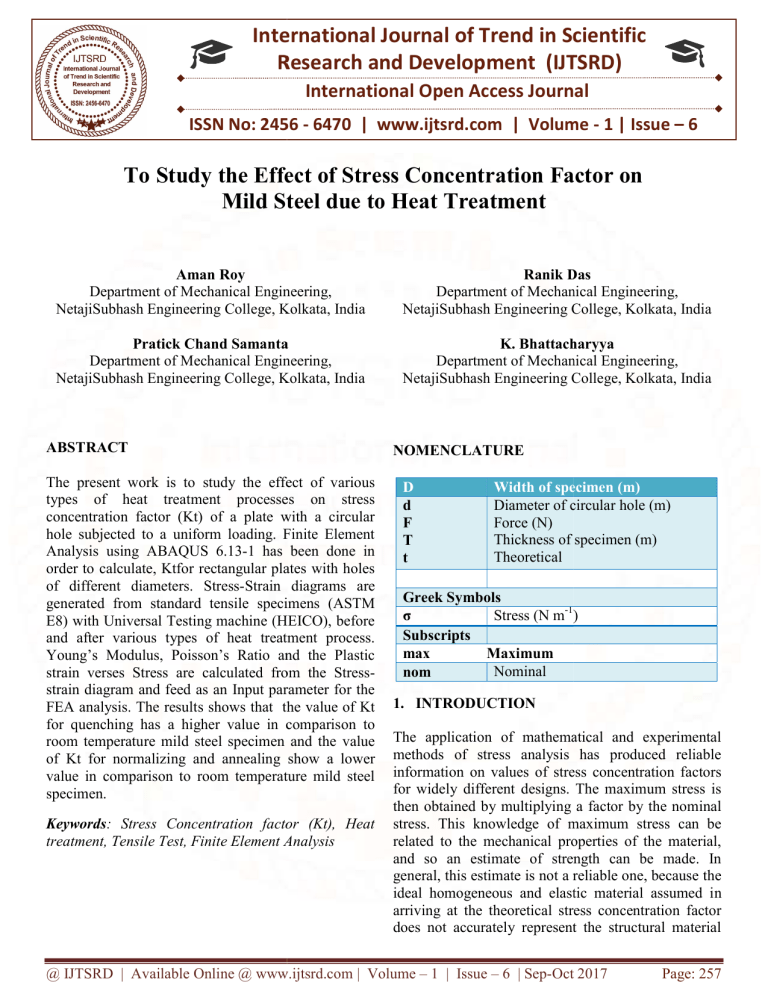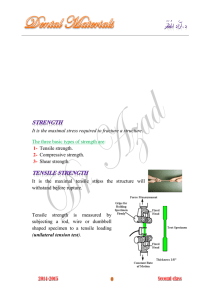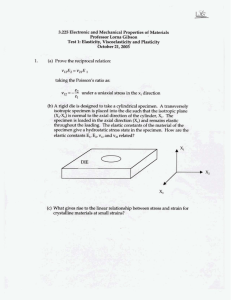
International Journal of Trend in Scientific
Research and Development (IJTSRD)
International Open Access Journal
ISSN No: 2456 - 6470 | www.ijtsrd.com | Volume - 1 | Issue – 6
To Study the Effect of Stress Concentration Factor on
Mild Steel due tto Heat Treatment
Aman Roy
Department of Mechanical Engineering,
NetajiSubhash Engineering College, Kolkata, India
Ranik Das
Department of Mechanical Engineering,
NetajiSubhash Engineering College, Kolkata, India
Pratick Chand Samanta
Department of Mechanical Engineering,
NetajiSubhash Engineering College, Kolkata, India
K. Bhattacharyya
Department of Mechanical Engineering,
NetajiSubhash Engineering College, Kolkata, India
ABSTRACT
The present work is to study the effect of various
types of heat treatment processes on stress
concentration factor (Kt) of a plate with a circular
hole subjected to a uniform loading. Finite Element
Analysis using ABAQUS 6.13-11 has been done in
order to calculate, Ktfor rectangular plates with holes
of different diameters. Stress-Strain
Strain diagrams are
generated from standard tensile specimens (ASTM
E8) with Universal Testing machine (HEICO), before
and after various types of heat treatment process.
Young’s Modulus, Poisson’s Ratio and the Plastic
strain verses Stress are calculated from the Stress
Stressstrain diagram and feed as an Input parameter for the
FEA analysis. The results shows that the value of Kt
for quenching has a higher value in comparison to
room temperature mild steel specimen and the value
of Kt for normalizing
ng and annealing show a lower
value in comparison to room temperature mild steel
specimen.
Keywords:: Stress Concentration factor (Kt), Heat
treatment, Tensile Test, Finite Element Analysis
NOMENCLATURE
D
d
F
T
t
Width of specimen (m)
Diameter of circular hole (m)
Force (N)
Thickness of specimen (m)
Theoretical
Greek Symbols
Stress (N m-1)
σ
Subscripts
max
Maximum
Nominal
nom
1. INTRODUCTION
The application of mathematical and experimental
methods of stress analysis has produced reliable
information on values of stress concentration factors
for widely different designs. The maximum stress is
then obtained by multiplying a factor by the nominal
stress. This knowledge of maximum stress can be
related to the mechanical properties of the material,
and so an estimate of strength can be made. In
general, this estimate is not a reliable one, because the
ideal homogeneous and elastic material assumed in
i
arriving at the theoretical stress concentration factor
does not accurately represent the structural material
@ IJTSRD | Available Online @ www.ijtsrd.com | Volume – 1 | Issue – 6 | Sep-Oct
Oct 2017
Page: 257
International Journal of Trend in Scientific Research and Development (IJTSRD) ISSN: 2456-6470
2456
actually used in practice. This causes observed
strength values of notched parts to be equal to or
greater than, that which is indicated by the direct
application of theoretical stress concentration factors.
Stress concentration is defined as the localization of
high stresses due to the irregularities present in the
component and abrupt changes of the cross section.
To determine the stress concentration
tration the specimen is
subjected to a uniform load for different diameters of
hole present in it. Since the area around the hole is
less there is a sudden rise in the magnitude of stresses
in the vicinity of the hole.
The localized stresses in the neighbourhood of the
hole are far greater than the stresses obtained by
elementary equations as mentioned in Mechanical
Engineering Design [1]. But due to heat treatment the
mechanical properties get altered thus the stresses get
changed.
Fig. 1: Tensile test specimen.
The percentage of carbon in mild steel is less which
makes it strong and tough but not radially tempered.
When the mild steel is heated above its
recrystallization temperature, where deformed grains
are replaced by a new set of defects-free
defects
grains that
nucleate and grow until the original grains are entirely
consumed due to which the mechanical
mechani properties get
changed.
3. EXPERIMENTAL PROCEDURE
3.1 Heat treatments
The heat treatments that have been performed in this
study are Annealing, Normalising and Quenching[4].
Localised stress is being calculated as
𝜎
=
F
(D d)T
(1)
In order to consider the effect of stress concentration
and find out localised stresses, a factor called stress
concentration factor is used
The stress concentration factor (Kt) is calculated from
the nominal stress 𝜎nom obtained from Eq. (1) and
maximum stress 𝜎max from FEA. The stress
concentration factor is calculated as
K =
max
nom
(2)
As, Kt is a very important factor in machine design
various works have been done on stress concentration
by various researchers like Shaik and Mirzana [2]
with composite material; sun et al. [3] on upper yield
point of mild steel but this work is mainly focused on
the change in the nature of Kt on mild steel before and
after heat treatment.
Fig. 2: Heating the tensile test specimens above its
transformation temperature.
mperature.
The tensile test specimens were kept in the
furnace
30 degrees above the recrystallization temperature of
mild steel which was found to be 880 degree Celsius
for 20 minutes shown in fig. 2. For Annealing the
tensile test specimen was cooled
coole in the furnace itself
by keeping it for 24 hours, for Quenching the
specimen was bathed in water pool and for
Normalizing it was kept in steady air at room
temperature for 4-5 hours.
3.2 Tensile test
The tensile test is performed on the specimen before
and
nd after heat treatment in Universal Testing Machine
(HEICO) shown in Fig 3.
2. SPECIMEN
The specimen is made up of mild steel
@ IJTSRD | Available Online @ www.ijtsrd.com | Volume – 1 | Issue – 6 | Sep-Oct
Oct 2017
Page: 258
International Journal of Trend in Scientific Research and Development (IJTSRD) ISSN: 2456-6470
2456
4. FINITE ELEMENT ANALYSIS
Elasto-plastic
plastic analysis for different diameter of hole
in the specimen is performed using ABAQUS 6.13-1.
6.13
The material consecutive properties are defined by the
Young’s modulus and Poisson’s ratio, and yield stress
verses plastic strain obtained from tensile test data
performed at room temperature before and after heat
treatment in Universal Testing Machine (HEICO) in
Fig. 3. The data obtained from the tensile test are
being plotted in the fig. 8, after subtracting the elastic
strain from the total strain we get the plastic strain and
corresponding plastic stress are obtained.
Fig. 3: Universal Testing Machine (HEICO)
Due to the dual phase strengthening mechanics; the
mild steel has a good balance of strength and ductility.
The yield stress value for the quenched specimen was
observed to be greater than that of normalized and
annealed specimens, while the normalized specimen
also has a greater value than that of annealed
specimen, which has the least value.
Engineering stress/strain was obtained from tthe
tensile test. These values were converted to true
stress/strain values by the following Eq. (3) and Eq.
(4) [5, 6]
𝜀
= ln(1 + 𝜀
𝜎
= 𝜎
(3)
)
(1 + 𝜀
)
(4)
The value of ultimate tensile stress were observed to
be in the order Quenched> before heat
treated>Annealed>Normalized, possibly due to the
refinement of the grains at primary phase after the
subsequent cooling processes. The ultimate stress and
the
he yield stressof the material after and before heat
treatments are enlisted in the Table 1.
Table
able 1: Yield stress and ultimate stress for
different tensile test specimen.
Tensile test Yield stress Ultimate
specimen
(MPa)
stress
(MPa)
307.701
615.403
Without
heat
treatment
733.805
1386.742
Quenching
406.992
Normalizing 250.457
198.858
423.495
Annealing
Three dimensional final modelling of the mild steel
s
plate has been done for a constant thickness of 5mm.
The FE model was meshed with 8 node isoperimetric
hexahedral elements with 8 Gauss points taken for all
calculations. Reduced integration with full Newtonian
non-linear
linear analysis computation is carried
carri out for all
the specimens. The mesh size is kept 0.9mm
throughout the specimen. Since large strain is
expected near the circumference of hole,
perpendicular to the direction of applied load.
Material non linearity is being introduced in the
specimen; large
rge strain analysis in the FE model is
incorporated. The stress distribution pattern on the
plate without heat treatment, Annealing, Normalizing,
and Quenching is shown in Fig.4, Fig.5, Fig.6 and
Fig.7 respectively.
Fig. 4: FEA of the plate with a circular
cir
hole of
dia.0.015mm without heat treatment.
Fig. 5: FEA of the plate with a circular hole of
dia.0.015mmafter annealing.
@ IJTSRD | Available Online @ www.ijtsrd.com | Volume – 1 | Issue – 6 | Sep-Oct
Oct 2017
Page: 259
International Journal of Trend in Scientific Research and Development (IJTSRD) ISSN: 2456-6470
2456
Fig. 6: FEA of the plate with a circular hole of
dia.0.015mmafter normalizing.
Fig. 8: Stress strain curve before and after
different heat treatments.
5.2 Effect of heat treatment on stress concentration
factor
Fig. 7: FEA of the plate with a circular hole of
dia.0.015mmafter quenching
Since, after heat treatment the steel changes its
properties
5. RESULTS & DISCUSSIONS
5.1 Stress Strain nature of Mild steel
Stress strain curve is the behaviour of material when it
is subjected to uniform load. Annealing produce
refined microstructure and normalizing provide
uniformity in grain size, for which the specimen’s
hardness gets decreased. Quenching reduce grain size
of the specimen, hence making the specimen harder.
As stress is a factor of hardness, the stress also gets
changed.
The input parameters, Young’s modulus are
calculated from the slope of the stress strain graph
before yield stress and Poisson’s ratio is calculated by
dividing transverse strain by lateral strain.
This change of stress due to different heat treatments
is shown in the fig.8.
The Stress Concentration factor (Kt) obtained from
the experiment for different d/D values before and
after heat treatment are enlisted in Table 2.After heat
treatment due to the transformation of crystals the
hardness of mild steel gets changed as stated earlier.
Stress concentration factor being a factor of stress,
also gets changed.
Table
ble 2: Stress concentration factor for
different values of d/D
d/D
Kt
Witho Anneali Normali Quenchi
ut
ng
zing
ng
heat
treatm
ent
1.82
1.659
1.79
1.79
5/30
1.96
1.331
1.67
1.96
10/30
15/30
1.554
1.046
1.26
1.931
20/30
1.096
1.112
0.96
1.817
25/30
1.026
0.676
0.677
1.238
Due to heat treatment there is a change in stress of the
material as observed in fig.8, thus the stress
concentration factor also gets altered. For annealing
and normalizing due to uniformity of crystal structure
stress generated in the specimen is less than
th stress
generated in normal specimen. In quenching due to
the formation of finer grains, stress generated in the
specimen is comparatively less than normal specimen.
@ IJTSRD | Available Online @ www.ijtsrd.com | Volume – 1 | Issue – 6 | Sep-Oct
Oct 2017
Page: 260
International Journal of Trend in Scientific Research and Development (IJTSRD) ISSN: 2456-6470
2456
Hence, stress concentration factor varies. This change
of the nature of Kt with d/D are being plotted in the
Fig. 9 before and the heat treatment processes.
Fig. 9: Stress concentration factor of mild steel
before and after heat treatment.
CONCLUSION
From the results obtained from the experiment, it can
be concluded that mechanical properties depends
mainly on the various heat treatment and cooling rate.
Thus, depending upon the application proper heat
treatment should be adopted. Since, for annealed
metal Kt is low hence it should be used for high
ductility
uctility and minimum toughness. Whereas for
maximum hardness normalizing the carbon steel will
give the satisfactory result, as Kt is maximum.
REFERENCES
1) Budynas, R.G. and Nisbett, J.K, 2011, Shigley’s
Mechanical Engineering Design. Ninth Edition,
McGraw-Hill Education.
2) Shaik, A.S. and Mirzana, I.M., 2016, IOSR
Journal of Mechanical and Civil Engineering
(IOSR-JMCE) e-ISSN:
ISSN: 2278-1684,p-ISSN:
2278
2320334X, Volume 13, Issue 4 Ver. VII (Jul. - Aug.
2016), PP 01-05.
3) Sun, H-B.,
B., Kaneda, Y., Ohmori, M. and Yoshida,
F, 2006, Materials Transactions, Vol. 47, No. 1
(2006) pp. 96 to 100 #2006 The Japan Society for
Technology of Plasticity
4) Totten (ed). Steel Heat Treatment Handbook.
vol.1. Metallurgy and Technologies, vol. 2,
Equipment and Process Design, 2nd edition. CRC
Press, Boca Raton, 2007.
5) Daris and Oelmann, The structures, properties and
heat treatment of metals. The Pitman Press
Great Britain, 1983.
6) Vijaty Sharan Sony Ericsson, Stress-strain
Stress
Modification-An
An Experimental and Analytical
Investigation of the Large Strain Compressive and
Tensile Response of Glassy Polymers, Polymer
Eng. And Science, vol. 30(20),pp. 1288-98,1990.
1288
@ IJTSRD | Available Online @ www.ijtsrd.com | Volume – 1 | Issue – 6 | Sep-Oct
Oct 2017
Page: 261





